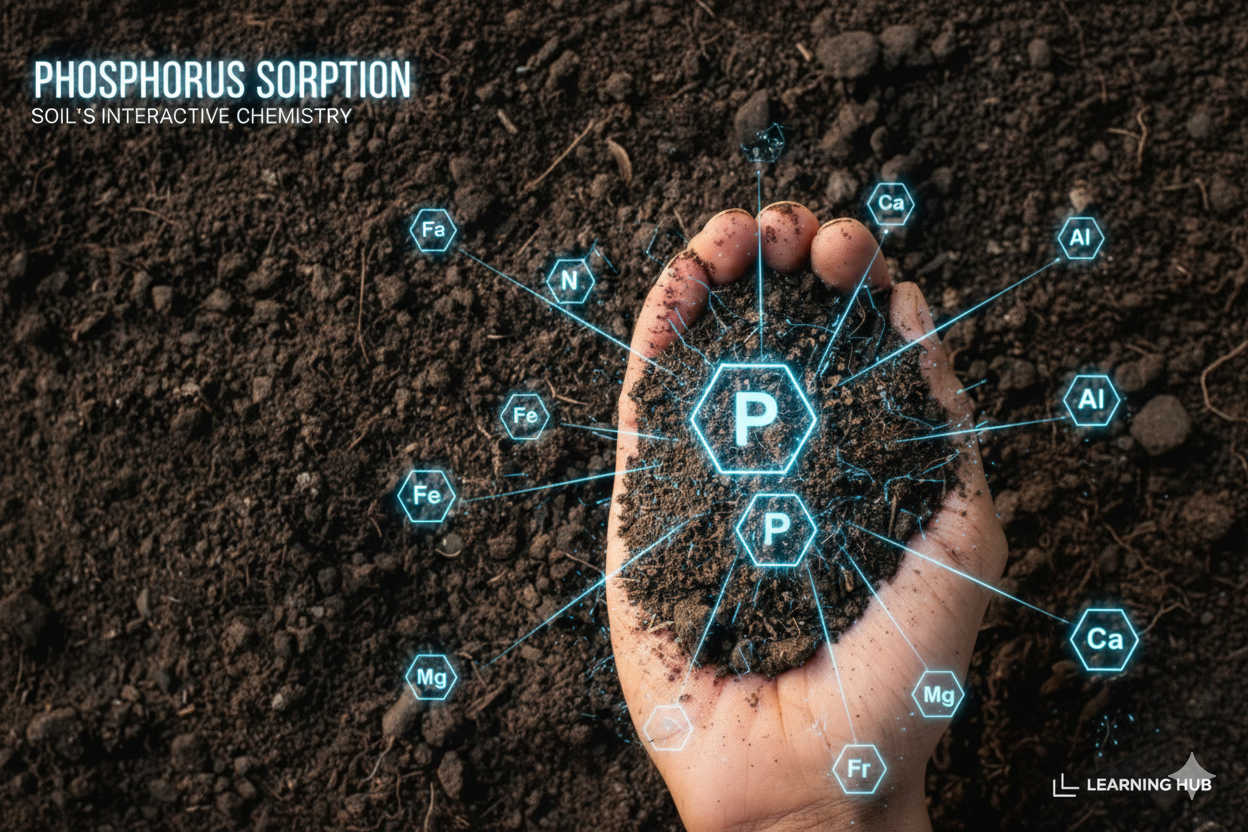Phosphorus (P) sorption
This is a key process in soil fertility, water quality, and nutrient cycling. It’s also referred to as P fixation. Unlike N fixation(Nitrogen is made available to plants), P fixation refers to the unavailability of phosphorus. Let me break it down in detail:
What is P Sorption?
Phosphorus sorption is the process by which phosphate ions from soil solution become attached (adsorbed) onto soil particle surfaces or bound (absorbed/precipitated) into soil minerals. It controls the availability of P to plants as well as its loss in runoff and leaching.
Main Processes of P Sorption
1. Adsorption:
This is most common in soils and it can occur in two ways:
- Outer-sphere complexation: This is a Weak electrostatic attraction of phosphate to positively charged surfaces (reversible or can easily be broken thereby releasing P into the soil solution for plants to utilize).
- Inner-sphere complexation: This is a Strong covalent or ligand exchange bonds between phosphate and hydroxyl groups on Fe/Al oxides or clay edges (less reversible because since Al is a part of the structure of the soil particle, Al being a cation will attract P being an anion and P may displace Al and take its place as part of the soil particle making it looks like P was naturally a part of the soil particle and when it gets to this stage of P fixation, it is difficult to break or reversed).
2. Precipitation:
This refers to the formation of insoluble phosphate minerals which cannot dissolve in soil solution making it unavailable to plants since plants can only get access to nutrients when the nutrients are in solution examples of insoluble phosphate minerals are: -Calcium phosphates: This is common in alkaline soils (Ca-P compounds like apatite).
Iron and aluminum phosphates which is common in acidic soils.
Diffusion into micropores:
P moves into inaccessible pores in soil minerals or organic matter where plant’s roots can’t get to making it less available to roots.
🔹 Factors Affecting P Sorption
- Soil Mineralogy: This is the natural mineral composition of the soil. They include -Fe & Al oxides also known as sesquioxides → strong P sorption (common in highly weathered tropical soils).
- Higher Clay content→ higher sorption capacity than sandy soils.
- Calcareous soils(soils with very high composition of Calcium) → Ca-phosphate precipitation dominates such soils thereby increasing the risk of P sorption
- Soil pH: Acidic soils : P sorption high due to Fe/Al oxides binding.
Alkaline soils: P precipitates with Ca.
*pH 6–7 is the Optimum range for maximum P availability.
Organic Matter:
- Organic anions compete with phosphate for sorption sites (can reduce P fixation).
- Humus can also form complexes with Fe/Al, reducing their ability to bind phosphate.
Phosphate Concentration:
- At low P → rapid sorption.
- At high P → sorption sites becomes saturated (meaning all positive sites which will want to attract P will be completely filled leaving no vacancy for Further P sorption) thereby increasing P availability.
Time (Aging effect):
With time, sorbed P can become occluded inside mineral structures, making it less available (irreversible fixation). 🔹 Measurement of P Sorption 1.Batch Equilibrium Studies :
Add different concentrations of phosphate to soil suspensions, shake, measure equilibrium P in solution. 2.P Sorption Isotherms : (Langmuir, Freundlich models)
Describe the relationship between sorbed and solution P.
- Parameters:
- Smax = maximum sorption capacity.
- K = bonding energy constant.
- Phosphorus Buffer Index (PBI) Used in Australia and other regions to indicate how strongly a soil can sorb P. 🔹 Environmental & Agricultural Significance
1.Agriculture:
P sorption reduces fertilizer efficiency (P becomes “fixed”).
Farmers often apply more P than crops immediately need to build up soil P to overcome fixation.
Management: liming acidic soils, organic matter addition and by banding P fertilizer.
- Environmental Impact:
- Strong sorption protects P from leaching into groundwater.
- Once sorption sites saturate, soils can become a P source, releasing P into waterways (eutrophication risk).
Summary:
P sorption is the binding of phosphate to soil particles mainly controlled by Fe/Al oxides, clay, Ca-carbonates, pH, and organic matter.
It’s a double-edged sword: it prevents P loss to water bodies but also limits plant-available P.


